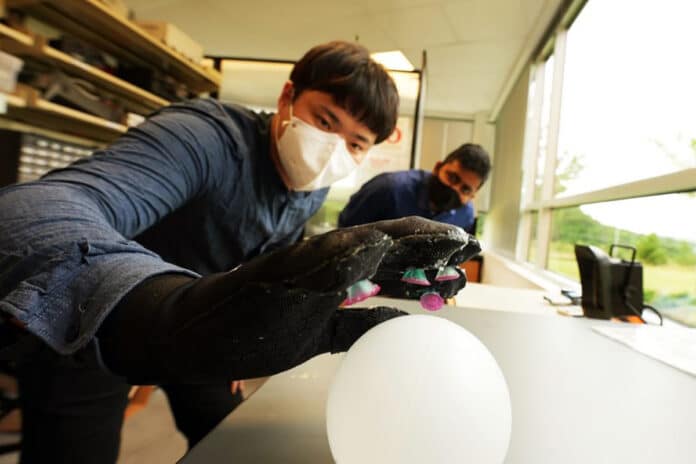Humans aren’t naturally equipped to thrive in an underwater environment. For humans, it is also very difficult to hold onto things in such an environment. Regardless, nature has numerous examples of organisms that have developed the ability to create strong attachments in moist or submerged environments.
Now, a team of researchers at Virginia Tech has developed an octopus-inspired glove capable of securely gripping objects underwater. The glove features rubber suckers and a sophisticated sensing capability that mimic the sea creature’s unique muscular and nervous systems.
The octopus is one of the unique creatures on the planet, equipped with eight long arms that can take hold of myriad things in an aquatic environment. These arms are covered with over 2000 suckers controlled by the sea animal’s muscular and nervous systems. Each sucker contributes a powerful snatching ability, and when its wide outer rim makes a seal with an object, muscles contract and relaxes the cupped area behind the rim to add and release pressure. When many of the suckers are engaged, it creates a strong adhesive bond that is difficult to escape.
Researchers recreate these capabilities for the human hand with the wearable system called “Octa-glove.” It features rubber stalks capped with soft, actuated membranes that mimic octopus suckers – activating a reliable attachment to objects with light pressure, ideal for adhering to both flat and curved surfaces.
For this, researchers added an array of micro-LiDAR optical proximity sensors that detect how close an object is. The suckers and LiDAR were then connected through a microcontroller to pair the object sensing with the sucker engagement, thus mimicking the nervous and muscular systems of an octopus.
“By merging soft, responsive adhesive materials with embedded electronics, we can grasp objects without having to squeeze,” Virginia Tech Assistant Professor Michael Bartlett said. “It makes handling wet or underwater objects much easier and more natural. The electronics can activate and release adhesion quickly. Just move your hand toward an object, and the glove does the work of grasping. It can all be done without the user pressing a single button.”
Their solution – a glove with synthetic suckers and sensors tightly integrated together – can grab many different shapes underwater. In tests, it manipulated delicate and lightweight objects, such as metal toys, cylinders, the double-curved portion of a spoon, and an ultrasoft hydrogel ball, using just a single sensor. By reconfiguring the sensor network to utilize all sensors for object detection, they also were able to pick up larger objects such as a plate, a box, and a bowl, even when users did not grab the object by closing their hands.
“These capabilities mimic the advanced manipulation, sensing, and control of cephalopods and provide a platform for synthetic underwater adhesive skins that can reliably manipulate diverse underwater objects,” said postdoctoral researcher Ravi Tutika. “This is certainly a step in the right direction, but there is much for us to learn both about the octopus and how to make integrated adhesives before we reach nature’s full gripping capabilities.”
Looking forward, the researchers envision the Octa-glove playing a role in the field of soft robotics for underwater gripping, applications in user-assisted technologies and health care, and in manufacturing for assembling and manipulating wet objects. It could be worn by rescue divers, underwater archaeologists, bridge engineers, and salvage crews to extract people and objects from the water.
